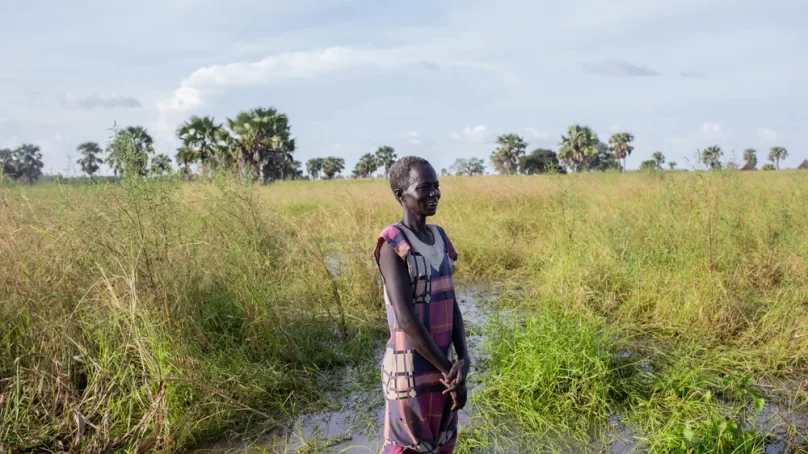
Seasonal flooding is normal in South Sudan as its topography funnels in water from neighbouring countries, but the scale of the issue since 2019 has no recent precedent. Experts say it is linked to climate change and the government’s weak capacity to respond.
The flooding has disrupted household production and spurred rural to urban migration. It has also pushed armed herders from the vast Sudd swamp into southern agricultural communities, leading to conflicts that political elites are again accused of fuelling.
“This year, there was a lot of bloodshed,” said Nhial Tiitmamer, director of the Environmental and Natural Resources programme at the Sudd Institute, a Juba-based think tank.
Individuals and communities have well-worn ways to cope with crises, but the back-to-back floods – which followed drought events in some areas and conflicts in others – mean these systems are now breaking down.
Mathot Deng, from Palal village, said his family survived crop destroying floods in 2019 and 2020 because they owned cattle. But the cows were raided during a conflict earlier this year, leaving Deng dependent on an NGO cash handout that is now almost exhausted.
Amou Agang from nearby Mabior Yar said she dealt with earlier floods by selling livestock and picking wild fruit. But heavy rains this year killed off her remaining animals, and standing floodwater has made it harder to forage.
Flood victims live by the side of the road in Mabior Yar, in Warrap state. “Vehicles often pass by, but nobody stops to help us,” said resident Amou Agang.
Agang is now living in one of a group of makeshift huts lining a dirt road that bisects Mabior Yar. “Vehicles often pass by, but nobody stops to help us,” she told The New Humanitarian while standing in cloudy, knee-deep water.
South Sudan’s government said last month it would allocate $16 million for humanitarian aid to flood-affected communities. Yet funding has not yet materialised and activists like Yakani have raised questions about the companies being contracted.
Other state interventions have proved controversial. Earlier this year, a government official called for the resumption of the Jonglei canal project, a century-old proposal to divert water from the Sudd swamp – Africa’s largest wetland – downstream to Egypt.
Officials claim the project – and other efforts to dredge Nile tributaries – would reduce flooding around the swamp. But critics say the project is in the interests of water-scarce Egypt and not the millions of South Sudanese dependent on the precious wetland.
Tiitmamer, of the Sudd Institute, said reviving the Jonglei project would be a “huge disaster” and called for other options to be pursued, like building dams and modern dikes, and setting up an early warning system to alert people to impending floods.
For now though, most interventions are being led by humanitarian organisations, which are focused on emergency relief and the construction of makeshift dikes that, according to Tiitmamer, “just aren’t really sustainable”.
Plans for more durable flood management projects are in the works from international organisations, but Tiitmamer fears they won’t be sufficient. “The whole country has been affected and these projects won’t even help a quarter,” he said.
Economic problems are also increasing humanitarian needs. The cost of staple goods in places like Warrap has doubled in recent months – a consequence of the war in Ukraine as well as local currency depreciation and other supply chain disruptions.
Deng, of Palal village, said price rises eroded the value of the cash assistance he received in July. That left him able to buy flour but not vegetables – a diet that has caused his weight to fall and his children to become malnourished.
Price inflation has contributed to a doubling in daily malnutrition cases at the main hospital in Tonj town, said Agany Monychol, the doctor who has run the centre since 2016. “It is the worst [situation] since I got here,” he told The New Humanitarian.
The problem isn’t limited to rural areas. Food sellers at Juba’s largest market aren’t able to sell all their goods because people can’t afford them, said Vicky, a 19-year-old vendor. “Customers will come, but when they get the price, they just leave,” she said.
Humanitarian funding shortfalls – worsened by donor reallocations to Ukraine – have caused further shocks. In June, the World Food Programme suspended aid to 1.7 million people – a decision it said meant taking from the hungry “to feed the starving”.
Assunta Adhieu Adiu coordinates humanitarian work in Tonj South county. She said food aid and donor funding for hospitals have decreased in recent months and that people “are feeling pain” as a result.
A month later, donor funding for the Tonj hospital was also cut by 30 percent, while support for three other Warrap health centres was severed completely, said Assunta Adhieu Adiu, a public official who coordinates humanitarian work in the area.
Monychol said cuts have left patients without basic drugs and forced him to reduce staffing. He has also shelved plans to improve the hospital – from buying new mattresses to replacing an iron roof that traps heat in a stuffy paediatric ward.
When asked how he felt seeing Ukraine dominating headlines and pulling away funding, Monychol pointed at those bedbound around him: “Patients [here] are suffering,” he told The New Humanitarian. “We need people to pay attention.”
The New Humanitarian reported in Tonj as part of a press trip organised by Save the Children. Transportation to and from Tonj and accommodation within the town was covered by the NGO.
- The New Humanitarian report











